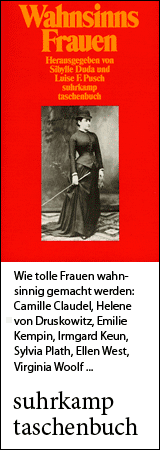
born April 23 1951 on Ebeye Island in the Marshall Islands
died June 18 1996 on Majuro Island in the Marshall Islands
Anti-nuclear Activist and Marshall Islander
Biography • Weblinks • Literature & Sources
Biography
“We are testing these bombs for the good of mankind and to end all wars.” So spoke a U.S. Navy officer in 1946 – the year after the bombing of Hiroshima and Nagasaki and the end of World War II – to explain to the people of the Marshall Islands in the Pacific Ocean why the U.S. was about to embark on a series of tests of nuclear bombs there. The same year, a U.S. Navy press release included this statement: “The natives are delighted, enthusiastic about the atomic bomb, which has already brought them prosperity and a new promising future.”
Darlene Keju would strongly disagree. Between 1946 and 1958, a total of 67 bombs were tested in the Marshalls – atomic bombs like the ones used in Japan, and the much more powerful hydrogen or thermonuclear bombs. Islanders were exposed to high levels of radioactive fallout, resulting in a wide range of devastating health problems, including radiation sickness, cancers, and severe birth defects. Many were evacuated to ostensibly safer islands; many have never been able to return, their home islands were so contaminated.
Darlene was born in 1951 on the island of Ebeye and raised on her mother’s island, Wotje. Due to a veil of secrecy and untruths that surrounded the bomb tests and their effects on living beings and the environment, she was in her late twenties before she began to learn the full story. But in the following years, until she herself died of breast cancer in 1996, she galvanized anti-nuclear sentiment in the Marshalls, documented the experiences of many who were affected, and traveled widely to speak to large audiences and let the world know what had been going on.
In 1967, when Darlene was sixteen, her parents sent her to Hawaii to get a formal education. She attended high school and college there, and finally the University of Hawaii’s School of Public Health, where she earned a master’s degree in 1984. During those seventeen years she made frequent trips back to the Marshalls and elsewhere, returning to the Marshalls permanently in 1984. In 1978 she attended a slide show presentation in Hawaii by Giff Johnson (later her husband and, after her death, her biographer), an editor and journalist who had become deeply concerned about the bomb tests and their effects. Darlene wanted to learn more, and was disturbed to realize that he knew more about the issue than she, a Marshallese person, knew.
She soon began to make up for lost time. She learned that in 1954, after six years of bomb testing in the Marshalls, the U.S. detonated, on the island of Bikini, the largest hydrogen or thermonuclear bomb ever. The test, code named “Bravo,” was a thousand times more powerful than the bombs the U.S. had dropped on Japan. The island’s residents had been evacuated to the island of Rongerik, and told that they would be able to return to Bikini in a short time. There they lived for about a year before a military medical official was sent to check on how they were doing; as it turned out, they were starving, due to shortages of food and water. Eventually they were evacuated to the island of Kili. In 1970, the U.S. sponsored a resettlement of some Bikinians on their native island, but eight years later they were found to have ingested high levels of radioactive cesium and had to be evacuated once again.
Unlike the residents of Rongerik, people living on the island of Rongelap, about a hundred miles east of Bikini and in the direct path of the fallout from “Bravo,” had not been evacuated. Attempts to explain how this happened included statements that the blast was larger than expected, and that the wind had shifted – statements that were later discredited and have given rise to suspicion that the people were being used as guinea pigs. On Rongelap, within a few hours of the blast, strange white powdery flakes began falling from the sky and covering everything on the ground. Children playing outside in what they thought was snow soon developed itchy skin irritations and a terrible thirst, and later skin burns and radiation sickness, starting with nausea and vomiting, diarrhea, and fever. Only after two days did authorities arrive and tell people to jump immediately into the water and swim to a boat headed for another island, Kwajalein. Three years later, in 1957, Rongalepese returned to their island, after being told it was safe. The Atomic Energy Commission stated tellingly, “The habitation of these people on the island will afford most valuable ecological radiation data on human beings.” However, people’s radiation levels were still found to be dangerously high. For nearly 30 years, they tried unsuccessfully to persuade the U.S. to move them to another, safer island. Finally in 1985 the Greenpeace ship Rainbow Warrior came to their aid, helping them move to the island of Mejato.
This pattern of removing people from one island to another, and of alternately claiming and denying that islands were safe to live on, continued, with some islanders being moved multiple times. “Bravo” was by no means the only bomb test that exposed Marshallese people and islands to radioactive fallout, nor did the fallout reach only four islands – Bikini, Rongelap, Enewetak, and Utrik – as the official view maintained. In 1979 Darlene and Giff went on a tour of about a dozen of the smaller outer islands that supposedly had not been exposed, and interviewed older residents about their experiences in the years since the blasts. Many people told of serious health problems such as tumors and cancers, and of the ruin and loss of a staple food crop, arrowroot. Women described reproductive problems such as miscarriages, stillbirths, and birth defects – including the births of “jellyfish babies,” babies so deformed that they did not look human and lived for only a few hours. People from the different islands started to realize that they had similar stories, giving the lie to the official denial that fallout had reached them. Keju later recalled, “This is when I made a personal commitment to the Marshallese victims that I would do what I could to help them.”
Increasingly angered by what she was learning, Darlene Keju began writing letters to U.S. government agencies, asking for information about the bomb testing. She worked with others on the Micronesia Support Committee, which ran panel discussions and slide presentations, and sent out newsletters to raise awareness of Marshallese concerns. In 1980 Keju attended a Nuclear Free and Independent Pacific conference in Hawaii, where she deepened her understanding that issues of political sovereignty – then a critical topic in the Marshalls – and freedom from nuclear weapons testing were closely connected. That same year, she flew to the U.S. mainland to participate in a Native American event – the International Survival Meeting in the Black Hills in South Dakota, one of the goals of which was to stop the exploration of the rich uranium deposits in the area. In the early 1980s she met Dr. Rosalie Bertell, author of No Immediate Danger: Prognosis for a Radioactive Earth, a scientist who had investigated radiation contamination in several areas and who was on a speaking tour that included Hawaii. With Dr. Bertell, Keju began to plan an epidemiological study of numerous islands, but the project was not approved by the conservative Marshall Islands government.
Keju visited the U.S. west coast early in 1983 to spread her message, speaking in numerous cities and giving interviews on radio and television. Her tour ended with a speech at a center of anti-nuclear protests – Vandenberg Air Force Base in Lompoc, California, site of the launching of test missiles to targets in what had become the Kwajalein Missile Range in the Marshall Islands. In 1984 she went on a speaking tour of both U.S. coasts and Canada, continuing to inform audiences of the horrific consequences of bomb testing in the Pacific.
In the nuclear resistance movement, Darlene Keju is perhaps best remembered for an address she gave in Vancouver in 1983 before an international audience, the World Council of Churches Assembly, on the weapons testing issue. A slight woman in a simple red dress, she spoke sternly and passionately, without notes or a prepared text. Keju's words had a huge impact in waking people up around the world to this toxic legacy, thanks to her forceful and inspiring presentation and her ability to make it frighteningly real. Toward the end of her address she said, “when the United States tells us they are here to protect us, we turn around and ask them, ‘Protect us from whom? We have no enemies. In fact, you might be interested to know that us Marshallese do not have a word for ‘enemy.’” And finally, “All we know is that we must travel throughout the world and share this kind of experience from the bombs so that we must stop it before it gets to you. Remember we are the victims of the nuclear age. Don’t become a victim.”
Keju’s interests broadened in the 80s and 90s to include public health issues generally, which naturally included being free of nuclear contamination. By all accounts she had a real flair for the dramatic, coming up with creative ways, such as music and dance programs and skits, to engage people – especially young people – in working to ensure a healthy life style and to instill a sense of pride in being Marshallese. To carry on this tradition, she formed the group Youth to Youth in Health. Tragically, in 1991 Darlene Keju was diagnosed with breast cancer, and finally succumbed to it in 1996 at the age of 45. Today her words and her efforts are more timely than ever.
(This piece appeared originally in Thea Paneth’s blog “Annals of Nuclear Resistance” and is republished here with her kind permission.)
Author: Dorian Brooks
Links
Darlene Keju’s address to the World Council of Churches, Vancouver 1983
Literature & Sources
Zohl de Ishtar, ed., Pacific Women Speak Out for Independence and Denuclearisation (Christchurch, NZ: The Raven Press, 1998)
Jane Dibblin, Day of Two Suns: U.S. Nuclear Testing and the Pacific Islanders (New York: New Amsterdam Books, 1988)
Giff Johnson, Don’t Ever Whisper: Darlene Keju, Public Health Pioneer, Champion for Nuclear Survivors (Giff Johnson, 2013)
Image source: https://www.youtube.com/watch?v=1hxCGlA5oJQ
If you hold the rights to one or more of the images on this page and object to its/their appearance here, please contact Fembio.



